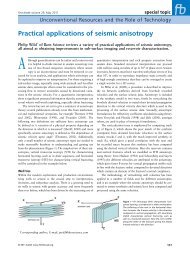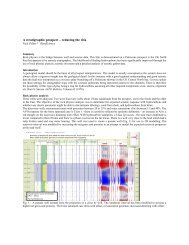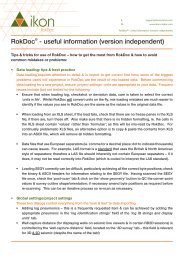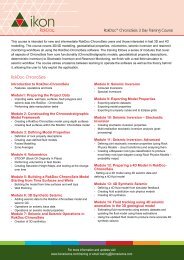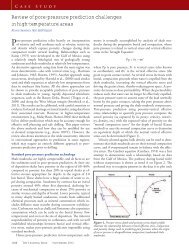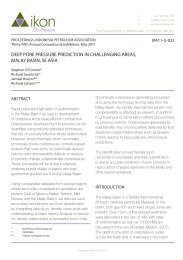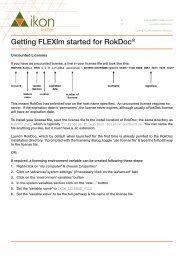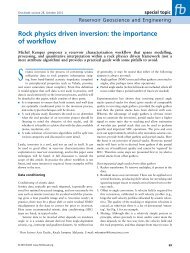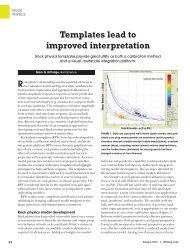the course outline pdf - Ikon Science
the course outline pdf - Ikon Science
the course outline pdf - Ikon Science
Create successful ePaper yourself
Turn your PDF publications into a flip-book with our unique Google optimized e-Paper software.
Essentials of Rock Physics for Seismic Amplitude Interpretation<br />
3 day Training Course<br />
Couse Contents - Lecture Topics<br />
1. Introduction<br />
The potential of seismic amplitude interpretation, for<br />
hydrocarbon detection. Seismic amplitude and risk.<br />
2. Fundamentals<br />
Seismic basics, approach to seismic modelling, elastic<br />
parameters, modelling reflectivity, relating seismic data to<br />
models<br />
3. Rock Properties and AVO<br />
AVO response description, rock property controls on AVO<br />
4. Rock Physics, AVO and Seismic Interpretation<br />
Seismic interpretation and AVO, trend curves and <strong>the</strong><br />
stratigraphic context of AVO, practical examples<br />
5. Characteristics of Seismic Wavelets<br />
Seismic bandwidth, zero phase and minimum phase, wavelet<br />
shape, zero phasing, enhancing frequency content<br />
analysis, seismic processing issues. Elastic inversion (EI,<br />
EEI), model based elastic inversions (2 and 3 term) for angle<br />
independent elastic parameters.<br />
12. Issues in Applying Rock Physics in Prospect<br />
Evaluation<br />
Course Contents – Exercises<br />
1. AVO scenarios<br />
2. Net pay prediction<br />
3. Which tie is best?<br />
4. Wavelets – where do you pick?<br />
5. Fluid substitution and AVA modelling<br />
6. Offset to angle<br />
7. Would you drill this bright spot?<br />
8. What is <strong>the</strong> likely interpretation of this amplitude anomaly?<br />
9. The sensitivity of AI inversion to <strong>the</strong> low frequency<br />
component<br />
10. Defining an AVO anomaly and <strong>the</strong> issues in Calibration<br />
6. Resolution<br />
Temporal resolution, net pay estimation and tuned responses,<br />
resolution – Sections vs. Maps<br />
7. Well Ties<br />
The well tie process, log calibration, <strong>the</strong> importance of<br />
wavelet shape, problems with assuming phase and timing, a<br />
quantitative approach to well ties<br />
8. Deriving Inputs for Seismic Models<br />
Gassmann’s equation, relevant rock physics for rock<br />
characterisation and fluid substitution<br />
9. Detailed Seismic Modelling<br />
10. Seismic Trace Inversion<br />
Seismic data and relative impedance, broadband inversion for<br />
absolute impedance, interpretation issues<br />
11. AVO Analysis<br />
2 term conventional AVO and <strong>the</strong> use of data projections(near<br />
far/ Intercept gradient). Data requirements for successful AVO<br />
For more information and updates visit<br />
www.ikonscience.com/training or email training@ikonscience.com




